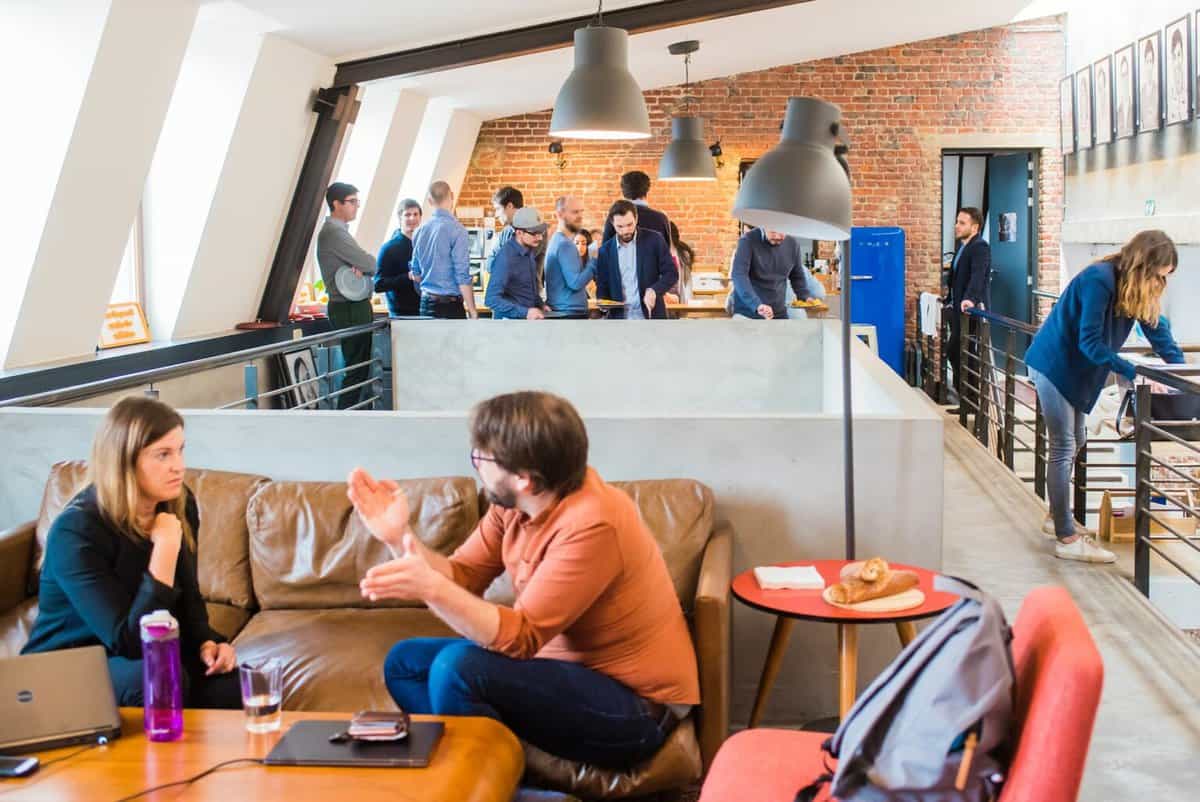Embracing Shared Living: A Modern Phenomenon
There’s a new trend sweeping across the urban landscapes of Europe, shaking up traditional ideas of home and community living. This trend, known as coliving, has quickly caught the attention of young professionals, startup entrepreneurs, digital nomads, and remote workers, becoming an appealing alternative to traditional apartments, solitary living or the unpredictable world of flatmates.
In coliving, members typically have a private bedroom or private apartment while sharing a host of communal areas, from a well-equipped, fully furnished kitchen to a relaxing lounge area or even a swanky rooftop terrace.
But as with any fresh concept, there are a set of unique coliving challenges that have emerged alongside its myriad benefits. This article will dive deep into those various coliving issues and provide a comprehensive understanding of the evolving landscape of coliving spaces.

Coliving Space: The Growing Magnetism
As the collaborative economy continues to flourish, the concept of coliving is gaining traction, especially in Europe. According to the Global Coliving Market Research report (2022), the coliving industry is expected to experience significant growth between 2022 and 2030, with Europe playing a pivotal role in this expansion. The forecast projects a remarkable Compound Annual Growth Rate (CAGR) for the region, indicating the rising popularity of coliving spaces.
The rising popularity of coliving can be attributed to its affordability, convenience, and social interaction benefits. As housing costs continue to increase and urbanization becomes more prevalent, people are searching for alternative and cost-effective living arrangements. According to the IMF eLibrary, the Netherlands is currently facing a housing crisis due to insufficient residential properties to meet the growing demand, causing concerns about the availability of affordable housing. As a result, coliving has become an appealing option for many residents who are struggling to find affordable housing.
While coliving addresses the demand for budget-friendly housing, it is not without challenges. Members often encounter expectations of privacy that may not fully align with the reality of shared living spaces. Striking a balance between personal space and communal interaction becomes a significant concern for those considering coliving arrangements.
As urbanization continues, the demand for alternative living options that foster community engagement and affordability will likely see higher prices persist, making coliving an essential part of the future housing landscape.

The Intricacies of Coliving Issues
As the concept of coliving gains popularity, it brings to light certain challenges that may not have been immediately apparent. According to The Global Coliving Market report, a considerable number of coliving members have expressed concerns about uncertain safety and conflicts with other members. To better understand these issues, let’s delve deeper into the intricacies of coliving problems.
The Illusion of Privacy
At first, the idea of living under the same roof with individuals who were strangers just a few weeks ago may seem like an exciting adventure. However, as time goes on, the novelty can wear off, and privacy concerns may arise. While coliving spaces typically offer individual locks on bedrooms, there is a fundamental need for trust when sharing living spaces with others. Knowing that personal belongings are secure when members are away or being able to sleep soundly without disturbances are crucial aspects of maintaining a peaceful living environment.
Lack of Space: The Inevitable Closeness
Coliving often brings an unavoidable proximity, where personal space may become a scarce commodity. As individuals come together to share a living environment, the physical boundaries blur, leading to potential discomfort. This lack of space can add an undercurrent of tension, exacerbating other issues within the shared space. Overcrowding may not only impact personal freedom but can also affect mental health, leading to increased stress and anxiety. Therefore, managing space and ensuring a degree of personal privacy and room to breathe becomes crucial in the design and operation of a successful coliving setup.
Safety First: Not Always the Case?
Another significant concern among coliving residents is the feeling of uncertain safety. Despite the provision of individual locks, safety becomes a collective responsibility when living in a communal environment. To address this challenge, some coliving spaces have taken proactive measures during the tenant selection process. By conducting structured or unstructured interviews, coliving companies aim to identify potential members who share similar values and interests. This thoughtful approach helps group together individuals who are likely to get along, fostering a stronger sense of community and trust.

The Shared Kitchen Conundrum
The shared kitchen, often seen as a hub of delicious culinary creations and spontaneous conversations, can sometimes turn into a source of conflicts. Small disputes, such as someone using your favorite mug or finishing the last bit of milk, have the potential to escalate into larger issues if not managed properly. In response to this challenge, some coliving spaces leverage interviews, surveys and personality assessments to match potential tenants based on their interests and personalities. By building a community of individuals who share similar values and preferences, coliving spaces aim to create a harmonious environment where residents can comfortably share communal spaces, including the kitchen.
Building Strong Communities
To mitigate potential conflicts and promote a more cohesive housing environment, coliving spaces are increasingly adopting the concept of openness and collaboration. By fostering an environment based on the sharing economy, coliving encourages residents to share common areas like cooking and living spaces while still having their own private bedrooms and bathrooms. By creating a place where members share similar philosophical values, coliving spaces strive to build a sense of belonging and mutual respect among residents.
Hence, the challenges of coliving can be effectively navigated through careful tenant selection, technological matchmaking, and the promotion of a collaborative community. By addressing privacy concerns, ensuring safety, and managing shared spaces thoughtfully, coliving can offer a fulfilling and enriching communal living space experience for its residents.
Navigating the High Seas of Conflict: A Survival Guide
Coliving has its perks, but it’s not without challenges. Drawing from experiences we have encountered in shared spaces across Europe, here are some tips to navigate the stormy seas of conflicts and forge robust communities.
Establish Clear Boundaries
Laying down house rules for shared living arrangement and common areas can help manage conflicts and maintain harmony. Whether it’s about keeping noise levels down after certain hours or respecting private spaces, setting these guidelines can help avert potential conflicts. Generally, the primary cause of conflicts in a shared living space is often traced back to unclear boundaries.
Tip in Action:
Gather all the residents for a comprehensive house meeting. During this meeting, encourage an open and respectful discussion about the common areas and the rules that need to be established. Allow each member to voice their concerns and preferences, ensuring that everyone feels heard and valued. Together, collaboratively decide on the guidelines that will govern shared spaces, such as the kitchen, living room, and common areas. By involving everyone in this decision-making process, there will be a sense of ownership and accountability for the agreed-upon rules. Once the guidelines are established, consider posting them visibly in common areas as reminders, helping to reinforce a culture of respect and understanding among all members.
Foster Open Communication
Transparent and open communication forms the backbone of any thriving community. Members need to express their concerns as they arise, rather than let them simmer and explode in an unmanageable conflict. It’s important to create an environment where everyone feels comfortable voicing their concerns and opinions.
Tip in Action
To foster open communication, consider implementing regular meetings where members can come together to share their thoughts, feelings, and any concerns they may have. Create a safe and supportive environment where each person feels comfortable expressing themselves. For those who may be more reserved, provide an alternative way to share their ideas, such as suggestion boxes placed in common areas. Additionally, leverage modern communication tools like group messaging apps to facilitate real-time discussions and announcements. These platforms enable members to stay informed, contribute to ongoing conversations, and address issues promptly, fostering a culture of open dialogue and trust.

Practise Shared Responsibility
A shared living space thrives when members practice shared responsibility. This can range from cleaning duties to events organization.
When all members commit to shouldering tasks big and small, the spirit of togetherness flourishes. Approach issues with patience and fellowship. See each chore as a chance to lift one another up, not instigate conflict. Through this lens, shared spaces nurture friendship over friction.
Tip in Action
To encourage shared responsibility, establish a rotating chore schedule that assigns various tasks to each member on a regular basis. Include a diverse range of responsibilities, from daily chores like cleaning common areas to planning and organizing events. By involving everyone in the decision-making and execution of these tasks, members will feel a greater sense of belonging and purpose within the community. Encourage a supportive and collaborative atmosphere where individuals see their contributions as opportunities to support each other rather than merely fulfilling obligations. Through this shared effort, a spirit of camaraderie and mutual support will flourish, leading to a more harmonious and connected living environment.
Foster a Community Spirit
Community bonding activities can foster a strong sense of camaraderie among members. Coliving is known for its focus on creating a strong sense of community. Each space has its unique way of achieving, this, based on their values and available resources.
A variety of activities, like shared meals, yoga classes, skill-sharing sessions, hikes, game nights, and workshops, are organized to foster connections among members. Some provide the structure for these events and activities, saving members the trouble of planning them themselves.
Tip in Action
To foster a strong community spirit, consider designating a “Community Builder” role each month or on a rotational basis. The Community Builder will be responsible for planning and organizing various community bonding activities. Encourage creativity and diversity in event ideas to cater to the interests and preferences of different members. Such activities may include shared meals, yoga classes, skill-sharing sessions, hikes, game nights, workshops, and more. By having different residents take on this role, it not only ensures a variety of events but also empowers everyone to actively contribute to community building. Through these shared experiences, friendships will blossom, and a sense of belonging will strengthen, nurturing a vibrant and supportive coliving community.
Invest in Conflict Resolution Training
Conflicts are inevitable, but how we handle them can make all the difference. Investing in conflict resolution training can equip members with the skills to handle disagreements constructively.
Tip in Action
To effectively handle conflicts, consider investing in conflict resolution training for all members. This training can be conducted by professionals through workshops or provided through accessible online courses. Members will learn valuable skills, such as active listening, constructive communication, and finding win-win solutions to disputes. By equipping individuals with these conflict resolution tools, they will be better prepared to address conflicts with empathy and understanding, transforming potential sources of tension into opportunities for growth and strengthening the bonds within the community. Conflict resolution training not only benefits the coliving space but also equips members with lifelong skills applicable in various aspects of their personal and professional lives.
To better understand the evolving landscape of coliving spaces, we’ve compiled a comprehensive table summarizing the problems coliving residents experience and the potential solutions to tackle them effectively.
Coliving has the potential to revolutionize urban living, fostering a sense of community in an increasingly fragmented world. Navigating its challenges requires a balanced blend of open communication, clear boundaries, shared responsibilities, and a strong community spirit. With these strategies, we can create shared living spaces where individuals don’t just coexist but thrive together.

Embracing the Future of Coliving
Coliving is a progressive solution to urban living challenges, reflecting our yearning for connection, community, and affordability. Open communication, shared housing responsibilities, and a strong community spirit are vital to navigate its unique challenges successfully.
The strength of a coliving community lies in members coming together, listening, and finding inclusive solutions. It fosters a culture of cooperation, where individuals can grow, connect, and thrive in new city.
Coliving goes beyond physical spaces; it’s a way of life that emphasizes togetherness and belonging. By embracing diversity, valuing open communication, and nurturing a spirit of support, we create enriching living environments.
In this ever-changing world, coliving offers a chance to break free from isolation and build meaningful connections. Let’s move forward with the core tenets of the coliving experience – community, collaboration, and a shared sense of home. Together, we create a brighter future where no one has to navigate life alone.
The Citylifer Perspective
At The Citylifer, we understand that coliving isn’t merely a convenient housing option; it’s a lifestyle that thrives on community engagement, personal space, and a harmonious living environment. We don’t just advise on best practices; we integrate them into our services and products to ensure a fulfilling living experience for every resident.
A Balance of Privacy and Community
Recognizing the critical importance of personal space, each resident at The Citylifer enjoys the luxury of their own self-contained studio apartment. These spaces feature a private kitchen and bathroom, combining autonomy with the shared living experience. Further enhancing your comfort, our studios are meticulously designed to optimize storage and functionality. Our innovative “High Five” furniture set transforms your studio into a multifunctional space that can serve as a bedroom, office, walk-in closet, sports area, or entertainment room. Need more storage? Additional options are available within the building.
Fostering Safe and Intimate Communities
At The Citylifer, community comes above all else. To foster connections while maintaining a sense of familiarity, we limit each community cluster to a maximum of 25 residents. These clusters share a dedicated “Family Room”—a communal space designed for cooking, dining, watching movies, and more. This arrangement creates a setting where friendships flourish, enhancing residents’ sense of safety and overall satisfaction with their living conditions.
Proactive Conflict Management
While we all hope to avoid conflicts, the reality is that shared living spaces can sometimes lead to tension. To mitigate this, The Citylifer enforces comprehensive house rules, particularly focusing on cleanliness in shared areas, which are also regularly cleaned as part of our service package. In the unlikely event that conflicts do arise, our on-site management team is specially trained in conflict resolution. Additionally, each community cluster has its own “Trailblazer”—a seasoned resident who helps newcomers acclimate and aids in resolving any community disagreements.
Cultivating a Cohesive Community through Resident Engagement
We champion the principle of bottom-up facilitation, encouraging residents to take an active role in planning and evolving community events. This aligns activities more closely with the community’s preferences, promoting a sense of ownership and involvement. As communities strengthen, acceptance and social cohesion naturally follow, making it easier to navigate challenges and resolve conflicts swiftly.
By melding thoughtful design, an emphasis on community, and proactive conflict management, The Citylifer aims to redefine the coliving experience, making it more enriching and harmonious for all residents





